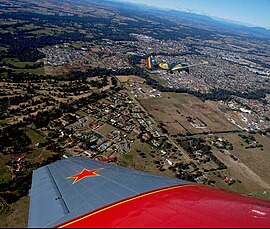This article needs additional citations for verification. (June 2024) |
| Wangaratta Victoria | |||||||||
|---|---|---|---|---|---|---|---|---|---|
 Aerial view from the north-west, Hume Freeway bypass somewhere around top, One and Three Mile creeks meeting around the middle. | |||||||||
| Coordinates | 36°21′30″S 146°18′45″E / 36.35833°S 146.31250°E | ||||||||
| Population | 29,808 (2021)[1] | ||||||||
| • Density | 517.5/km2 (1,340.3/sq mi) | ||||||||
| Elevation | 150 m (492 ft) | ||||||||
| Area | 57.6 km2 (22.2 sq mi)[2] (2011 urban) | ||||||||
| Time zone | AEST (UTC+10) | ||||||||
| • Summer (DST) | AEST (UTC+11) | ||||||||
| Location |
| ||||||||
| LGA(s) | Rural City of Wangaratta | ||||||||
| County | Moira, Delatite, Bogong | ||||||||
| State electorate(s) | Ovens Valley | ||||||||
| Federal division(s) | Indi | ||||||||
| |||||||||
Wangaratta (/ˌwæŋɡəˈrætə/ WANG-gə-RAT-ə[3]) is a city in the northeast of Victoria, Australia, 236 km (147 mi) from Melbourne along the Hume Highway. The city had a population of 29,808 per the 2021 Australian Census.[4]
The city is located at the junction of the Ovens and King rivers, which drain the northwestern slopes of the Victorian Alps. Wangaratta is the administrative centre and the most populous city in the Rural City of Wangaratta local government area.
- ^ "3218.0 – Regional Population Growth, Australia, 2017-18: Population Estimates by Significant Urban Area, 2008 to 2018". Australian Bureau of Statistics. Australian Bureau of Statistics. 2 February 2023. Retrieved 2 February 2023.
- ^ "2011 Census Community Profiles: Wangaratta". ABS Census. Australian Bureau of Statistics. Archived from the original on 11 November 2017. Retrieved 15 September 2016.
- ^ Macquarie ABC Dictionary, The Macquarie Library Pty Ltd, 2003, p. 1111, ISBN 1-876429-37-2
- ^ "2021 Wangaratta, Census All persons QuickStats". Retrieved 2 February 2023.
